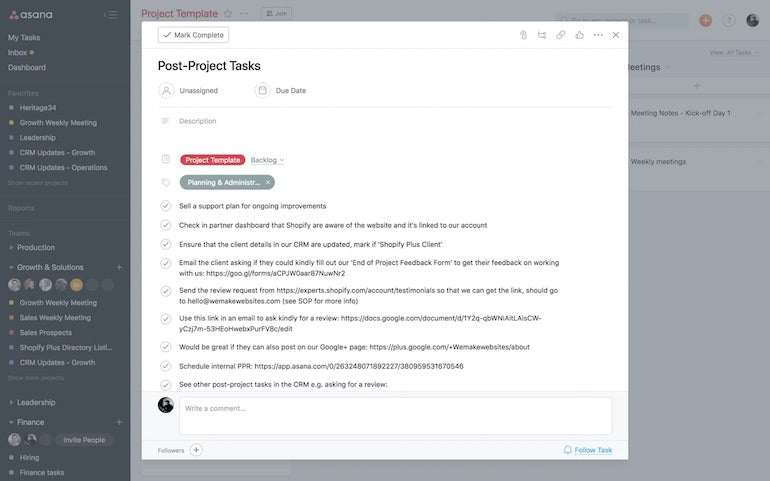
When you launch an agency, your mind fills with ideas and all the endless possibilities. It's an exciting journey after all. You believe you're in control of the type of clients and projects you take on, and that you can handpick superstars to join your team. You dream of a steady supply of clients and interesting projects to tackle.
However, for those of you that already run an agency, you know this dream is not always the reality—you know that there are trials and tribulations you’ll have to face along the way. How can you keep current clients on a retainer? When is your next client coming along? How can you differentiate yourself from the competition? Running an agency is a battle of riding the peaks and troughs of projects.
In 2018 at Shopify Pursuit’s stop in NYC, running an agency was a topic in discussion. Pursuit is an opportunity for Shopify Partners to meet and grow, learn, and connect on the ins and outs of entrepreneurship. In New York, those who were nine months into their adventure in building a business, to those who were growing a million dollar agency, came together to share their insights and advice. Below are 8 tips we learned.
1. Branding can be your competitive advantage
As your business grows, your brand should grow too. Most agencies start out as freelancers or business duos that build out their service offering, so it can be tough to refine your services and identify your niche early on. But doing so is key—the way you brand your business is essential. Providing a unique offering for clients helps you stand out from competitors.
In the early days, advertising agency Wondersauce branded themselves as a web development company, but they evolved quickly. “When branding our agency, the landscape was littered with tech-specific agencies that focused on mobile or social,” says John Sampogna, CEO and cofounder. “Everyone was trying to chase trends and what was ‘next’. We thought that instead, being full service is essential.”
Wondersauce branched out from web design as their single offering to include product photography and social media promotion. They found it critical to build an agency structure where their only constant was change. Change is the business motto they embraced that allowed them to scale their core offering.
Figure out your unfair advantage. It’s what puts a moat around your business.
Alex O’Byrne, Director at We Make Websites, offers some guidance on identifying your early stage branding: “Figure out your unfair advantage. It’s what puts a moat around your business.” For We Make Websites, their unfair advantage is that they’re an international business with experience working with brands globally. This branding helps them pry larger, global clients away from their competitors.
For smaller businesses, finding your unfair advantage can be a struggle. John recommends some practical tips to get there with your business partner or team.
“Get fluid on how merchants make money. Then, sit down with your team and label the three things that are their biggest challenges. Put all your creativity and focus into one of those things—that’s where you can excel your business.”

While it’s a big challenge, branding can’t be ignored. It is an essential part of helping your business land clients. If you’re struggling to get more clients, use the advice above and take an audit of how your brand is perceived. Are clients clear on your core offering? Do your website and partners listing clearly communicate this? These are questions worth asking and revisiting frequently, so build them into a quarterly or yearly review cycle.
You might also like: What is Personal Branding? A Freelancer’s Guide.
2. Drop the juggling act: learn to delegate and hire replacements
In the early stage of running a business, you’re a generalist. You’re the marketer, web designer, accountant, and many other roles that fall on your shoulders as a business owner. But flash forward a few years down the line, and this generalist attitude can become a problem. Founders can get caught between working on their projects and running their agency.
For Kelly Vaughn, founder of the Taproom Agency, this realization happened while she was 5 time zones away on vacation.
I needed to step back from working in my business, and start working on it.
“It was in the middle of my vacation and it hit me. I was putting out fires back in Atlanta from my sunbed. It was this moment that helped me realize that I needed to step back from working in my business, and start working on it. You can’t do everything, you’ll burn out.”
On her return, her immediate action step was to hand over work and empowerment to the project manager, so she could remove herself as the bottleneck.

Handing over ownership of duties you’ve handled for years isn’t that easy, no matter if you love or hate them. You need to learn to let go. Whoever you replace yourself with won’t do it your way, but that doesn't mean it’s wrong. As a leader, you need to encourage autonomy and avoid micromanaging.
For every position that you’ve appointed yourself to, you should write a job description for each role and hire to remove yourself.
Alex agrees. “You may still be doing web design, or development, project management, or managing adwords, whatever your operations are,” he says. “You are almost certainly still doing sales. You are working a job within your company, as well as being the CEO or President. That needs to change. For every position that you’ve appointed yourself to, you should write a job description for each role and hire to remove yourself.”
When it comes to hiring to replace yourself, John has some advice: hire for attitude, not skills. Skills can be trained.
“Find and hire a person who sees and believes the same things as you,” he recommends “Often you can’t shape attitude, since that’s internal and a change that has to come from themselves. But you can give them the resources and train them to be an expert.”
It's tough for founders to hand over responsibilities to new hires, but there's a damaging effect if you don’t. When the rest of the team can’t move forward because of you, then you become the bottleneck of the business.
You might also like: How to Hire Employees: The Essential List of Resources for Agency Owners.
3. Create procedures to reduce chaos
It can feel counterintuitive to put time aside and work on something that isn’t a client project. But standardizing a process is crucial to a successful business. Process, automation, and documentation is key to reducing the chaos in the business. Without them, it takes ten times longer to get work done, and you make ten times as many mistakes.
If your business structure is chaos, your life is chaos.
Kelly sums it up nicely. “If your business structure is chaos, your life is chaos.”
By outlining and standardizing ways to communicate information, you avoid important information getting caught up with stakeholders.
Below are some immediate steps you can take to reduce chaos.
- Don’t write the same email twice. Create a standard document of emails for onboarding clients, weekly project updates, reviews, and project handoffs. That way, you can streamline communication and slightly adapt each template to suit your client. Tools like Text Expander or the Google Chrome plugin Text Blaze can help you.
- Create a project board template. Isn’t it tiring creating a project board from scratch every time you start working with a new client? If you’re clear on your standard project scope, you can begin to build a standard project outline that you customize for each client you work with.

Creating a standard procedure can save you a lot of time in business. By taking time out from projects to create processes, you can save hours of duplicate work. It also creates a system in your business so all employees are able to be consistent across projects, and vital information isn’t locked up in people’s minds.
The Complete Guide to Web Design Project Management
Read our complete guide to web design project management for developers, designers, and marketers. Learn how to work with stakeholders, manage budgets, and keep your clients happy.
Learn more4. Invest in your team and employees
While you’re busy running an agency business, don’t forget about your team. While they don’t have to be best friends, creating relationships with colleagues and knowing them outside of work can help team alignment.
Once you’ve built the team, you now need to build the buy-in.
The struggle for Kelly was that she had a total of 9 employees who were all remotely distributed. “The team had a lack of familiarity with one another on a personal level,” Kelly recounts. “Yes, they talked when they were collaborating on projects, but there was no regular communication. And that’s a problem because once you’ve built the team, you now need to build the buy-in.”
For the Taproom Agency, Kelly’s solution was to align the team and set individual goals. She focused on being transparent with them, checking in regularly, and making the effort to celebrate them and the brand.
Alex echoes a similar sentiment. “Make sure you train folks and help them move up internally. People have career goals and you should look to support them. Losing some of your best talent because you didn’t help them reach their goals internally is tough. As a general rule, look to promote your superstars.”
The culture of the workplace can be something that wins you clients, new hires, and keeps current employees around. The way you run the workplace is just as important as winning your next client.
You might also like: How to Interview Candidates and Get Real Results.
5. Develop external partnerships
Partnerships with other businesses are a great way to grow your agency. Chase Clymer, cofounder of Electric Eye, has been building partnerships that have had a dramatic effect on the success of his business.
“We have partnerships with other agencies and with the apps we use in our tech stack,” Chase explains. “Each relationship is unique, and we try to talk to them at least once a quarter.”
To build partnerships, he suggests authenticy. “Don't be robotic—be genuine, and make friends. You need to build actual connections with real human beings. You are both looking for the same thing—a mutually beneficial partnership. If you think it would be a good relationship, make the first move. And be sure to lead with value without asking for anything in return.”

Many small web design and development agencies are excellent at rebrands and design, but often lack the expertise to implement ecommerce SEO, web copy, or build a sales funnel. In this case, it makes sense to partner with a marketing agency. It’s a way you can earn more, share clients, and grow together.
6. Avoid getting lost in day to day work, and market your agency
All the speakers at Pursuit NYC had the same warning for business owners: don’t get so lost working in your business that you forget to work on it. Tasks like marketing are just as important as the day-to-day operations of doing work for clients. And while marketing can be challenging, it’s important that it becomes a priority.
Marketing isn’t bragging about how good your business is. Marketing should be about contributing to a community, sharing your expertise, and adding value to clients or other Shopify Partners.
Some of the ways you can start adding value back to the community is by speaking at conferences like Pursuit or at Shopify Meetups.
For Alex of We Make Websites, speaking and hosting events have been key facets of marketing his agency. Doing so has provided an opportunity to connect with his audience, and help them out.
“We help our audience win, before we sell them anything.”
It was the perfect opportunity to both teach what I now know, and put the Taproom Agency on the map as a strategically planned Shopify agency with a very exciting future.
Kelly from the Taproom Agency echoes Alex’s outlook. “I've received so much good advice from other agency owners and seasoned managers. After my first year of running the Taproom Agency, I was confident enough in my own abilities and processes that I was eager to share what I've learned so far, which led me to giving a talk at Pursuit. It was the perfect opportunity to both teach what I now know, and put the Taproom Agency on the map as a strategically planned Shopify agency with a very exciting future.”
If speaking at events isn’t your style, there are many other ways you can add value back to the community. You could teach a class at a local college or specialist organization like General Assembly, or even create a course on Skillshare or Udemy.
You could also write a blog, or host a podcast like Shopify Expert Kurt Elster. Kurt led a Masterclass at Pursuit, where he discussed his merchant-facing Unofficial Shopify Podcast. During his masterclass, Kurt explained how his podcast serves as a helpful source of information, and how it plays an essential role in his marketing and sales strategy.
If teaching, conferences, podcasts, or meetups haven’t been on your radar as a marketing activity, perhaps it’s time to consider this venture. There’s huge value in being generous and contributing back to the community.

7. Prioritize how you handle and manage cash flow
It’s obvious that cash is the life blood of a business, but talking about how to manage cash flow is a bit of a taboo subject. This comes with good reason—not many business owners want to be completely transparent about overheads. However, cash flow was a subject John from Wondersauce wasn’t afraid to address.
“Even if you’ve been net positive for a year, two years or whatever, go down to the bank and get a loan,” John recommends. “Say your revenue is around 7 or 8,000 per month; don’t be afraid to get a loan of 200,000. There’s two reasons for this. First, if things are going well right now, it’s great that your business is ascending, but unfortunately you will hit a trough where there’s no new clients or new projects coming in. It’s better to get to the bank now and get that cash. This is especially true for when you don’t need it. Put it to the side and pay back those monthly installments. Second, you need to get used to making those consistent payments and building up that trust with the bank, because it will be a lot easier to have access to that money when you need it in the future.”

Alex agrees, and has a system that he recommends to other partners to keep that goal of being cash flow positive. “Retainers need to be paid ahead of the work,” he emphasizes. “If the full amount can’t be paid, take at least a 50 percent deposit upfront. If your client is able to pay in full before the work is carried out, we offer them a 10 percent discount on the total fee. And we’re always on the lookout to build up retainers of repeat work to cover our costs.”
It can be dangerous to assume that your cash flow will continue to grow as your business does. Set up a financial plan and payment structure so you can alleviate monetary worries as much as possible.
8. Don’t forget to invest in yourself
Yes, you’re very busy as an agency owner or founder, but you should never stop learning or looking to improve your work . It’s easy to put self-development aside when you’re dealing with a constant stream of tasks that always seem to be business critical. However, taking the time to level up your skills is an investment in your business.
. It’s easy to put self-development aside when you’re dealing with a constant stream of tasks that always seem to be business critical. However, taking the time to level up your skills is an investment in your business.
“Try taking a class, attend a conference or networking event, and treat yourself to an upgrade by purchasing new equipment.” Kelly recommends. “But more importantly, don’t forget to take care of yourself and meet your basic needs. Eat well, sleep for 8 hours, and take time off when you need it!”
It’s easy to get caught up growing your business, but don’t let attention and care about your health slip away. The time you spend away from your business is just important as the time you spend in it.
A final say on running an agency
Running an agency is an exciting journey. It’s how you navigate the peaks and the troughs that can help you build a sustainable business. Use this advice from partners at Shopify Pursuit, whether that’s hiring, marketing, or setting up deliberate processes to streamline your work. This advice can help you thrive as you move into unknown territory of running an agency.
Read more
- 7 Ways to Create an Amazing Customer Experience for Your Clients’ Ecommerce Stores
- Build Your Ecommerce Business: Livestream
- How to Boost Your Business’s Revenue with Ongoing Service Retainers
- How to Collect the Right Information from Your Clients
- Check Out This Free Ecommerce Training Business Course on Skillshare
- Grow Your Business With This Free Book
- 4 Key Ways to Differentiate Your Clients’ Ecommerce Stores From the Competition
- What You Missed at Generate Conference 2014
- Learn from the Shopify Experts Who Won Build A Business
What advice do you have to build a strong agency? Share your tips in the comments below!

